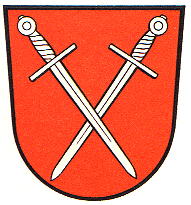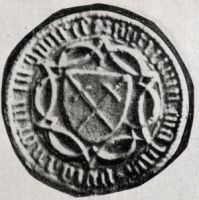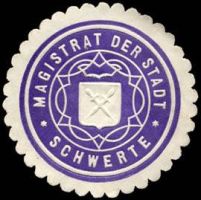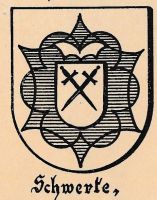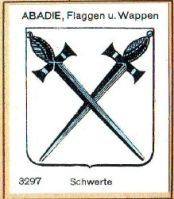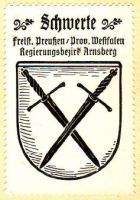Schwerte: Difference between revisions
Knorrepoes (talk | contribs) m (Text replacement - "{| class="wikitable"↵|+Official blazon↵|-↵|'''German'''↵| ↵|-↵|'''English''' ↵| {{blazon wanted}}↵|}" to "{| class="wikitable" |+Official blazon |- |'''German''' | blazon wanted |- |'''English''' | blazon wanted |}") |
Knorrepoes (talk | contribs) m (Text replacement - "{{de1}}" to "{{de}}") |
||
| Line 34: | Line 34: | ||
{{ | {{de}} | ||
{{media1}} | {{media1}} | ||
Revision as of 10:55, 25 July 2023
SCHWERTE
State : Nordrhein-Westfalen
District (Kreis) : Unna (until 1975 Iserlohn)
Additions : 1975 Amt Ergste (partly), Amt Westhofen, Ergste Geisecke, Villigst, Wandhofen, Westhofen
| German | blazon wanted |
| English | blazon wanted |
Origin/meaning
Schwerte received city rights in 1242 from Count Adolf I of the Mark. The oldest known seal dates from 1427, but it probably dates from 1397 when the city rights were confirmed. It already shows the two crossed swords, a canting symbol (Schwerter=swords). Ever since two swords have been on the seals and the arms of the city.
The colours, however, have changed regularly; until 1909 it was most often shown as black swords on blue. From 1911-19437 as black on silver (see below) and since 1947 as above. These colours were derived from a fresco found in the St. Victorchurch, which dates from the 15th century.
The arms in an album from around 1910
The arms in the Abadie albums
The arms by Hupp in the Kaffee Hag albums +/- 1925
This page is part of the German heraldry portal |
Heraldry of the World |
|
German heraldry:
|
Selected collector's items from Germany:
|
Literature: Stadler, 1964-1971, 8 volumes; Hupp, O: Kaffee Hag albums, 1920s
